Nursing Theories: Application of Orem's Self-Care and Borrowed Theory
VerifiedAdded on 2023/01/05
|7
|1599
|92
Essay
AI Summary
This paper critically examines the application of nursing theories, focusing on Dorothea Orem's Self-Care Theory and a borrowed theory. The analysis begins by highlighting the significance of nursing theories in guiding practice, education, and research, emphasizing their role in improving patient outcomes and decision-making. Orem's Self-Care Theory is discussed in detail, including its core concepts and application to elderly patients on peritoneal dialysis, supported by a study overview. The paper also explores a borrowed theory from another discipline, specifically the theory of motivation, and its relevance to nursing, using a study on ward staffing. The discussion includes the theoretical frameworks, methodologies, and findings of the studies, emphasizing how these theories contribute to a deeper understanding of patient care, professional boundaries, and organizational objectives. The paper concludes by underscoring the importance of integrating nursing theories into clinical practice to enhance patient outcomes and advance the nursing profession.
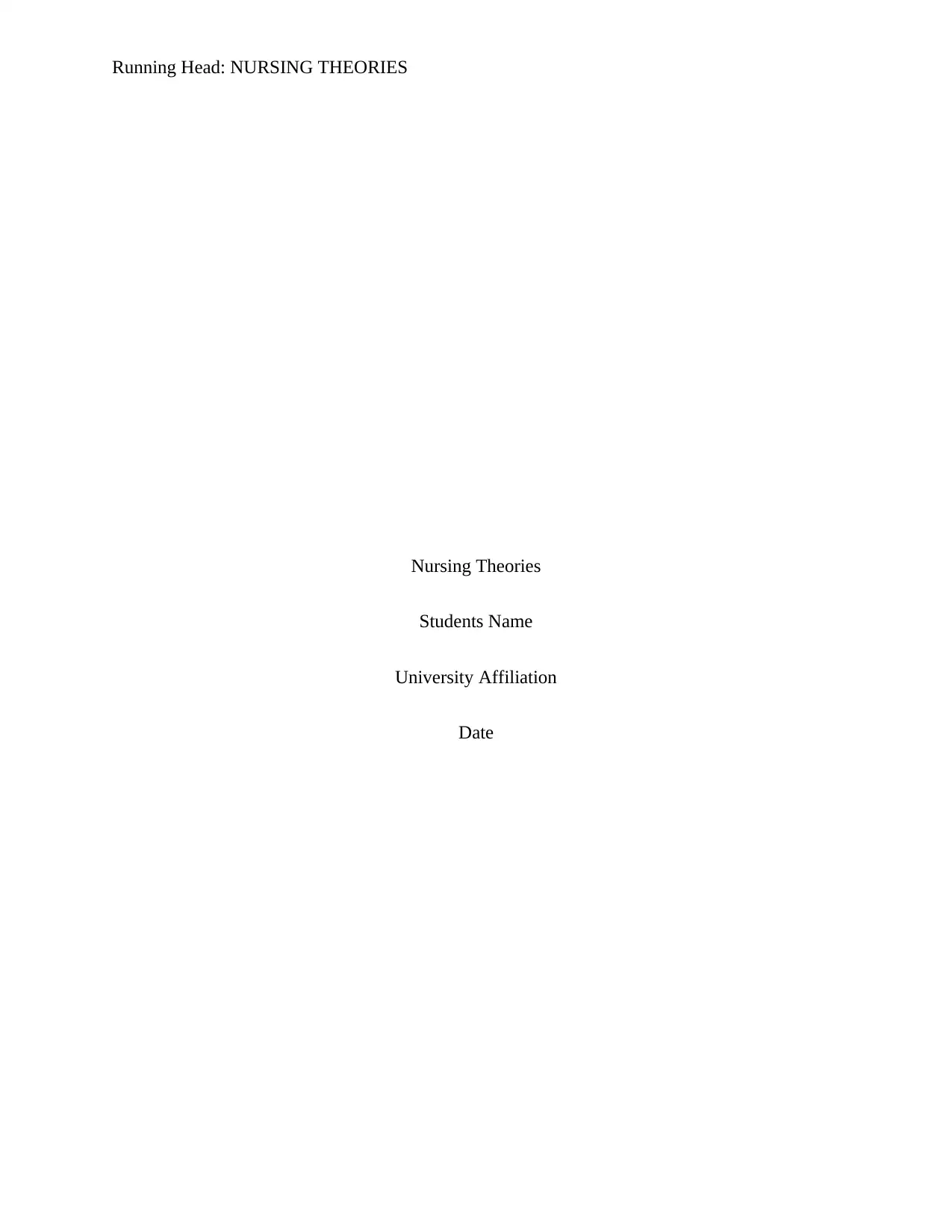
Running Head: NURSING THEORIES
Nursing Theories
Students Name
University Affiliation
Date
Nursing Theories
Students Name
University Affiliation
Date
Paraphrase This Document
Need a fresh take? Get an instant paraphrase of this document with our AI Paraphraser
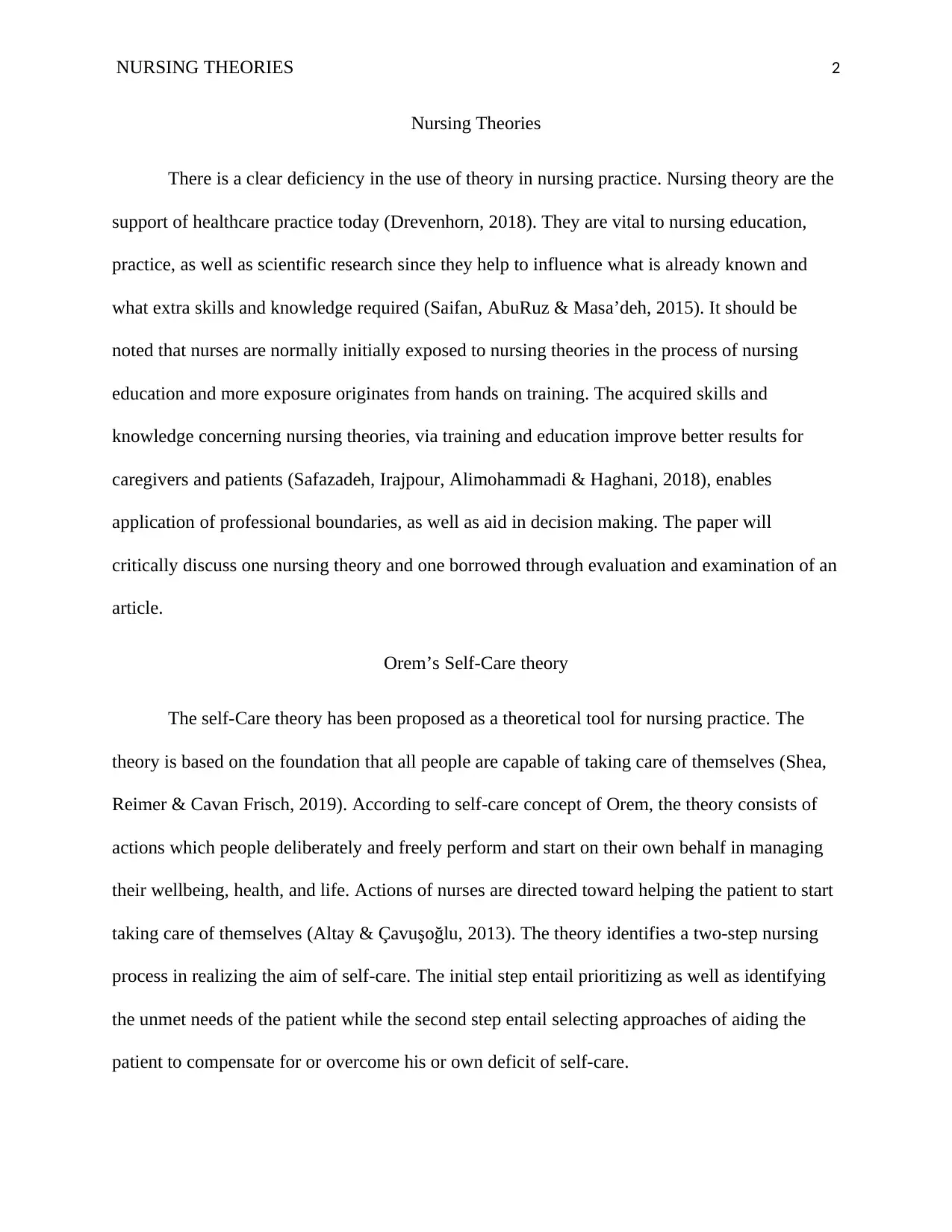
NURSING THEORIES 2
Nursing Theories
There is a clear deficiency in the use of theory in nursing practice. Nursing theory are the
support of healthcare practice today (Drevenhorn, 2018). They are vital to nursing education,
practice, as well as scientific research since they help to influence what is already known and
what extra skills and knowledge required (Saifan, AbuRuz & Masa’deh, 2015). It should be
noted that nurses are normally initially exposed to nursing theories in the process of nursing
education and more exposure originates from hands on training. The acquired skills and
knowledge concerning nursing theories, via training and education improve better results for
caregivers and patients (Safazadeh, Irajpour, Alimohammadi & Haghani, 2018), enables
application of professional boundaries, as well as aid in decision making. The paper will
critically discuss one nursing theory and one borrowed through evaluation and examination of an
article.
Orem’s Self-Care theory
The self-Care theory has been proposed as a theoretical tool for nursing practice. The
theory is based on the foundation that all people are capable of taking care of themselves (Shea,
Reimer & Cavan Frisch, 2019). According to self-care concept of Orem, the theory consists of
actions which people deliberately and freely perform and start on their own behalf in managing
their wellbeing, health, and life. Actions of nurses are directed toward helping the patient to start
taking care of themselves (Altay & Çavuşoğlu, 2013). The theory identifies a two-step nursing
process in realizing the aim of self-care. The initial step entail prioritizing as well as identifying
the unmet needs of the patient while the second step entail selecting approaches of aiding the
patient to compensate for or overcome his or own deficit of self-care.
Nursing Theories
There is a clear deficiency in the use of theory in nursing practice. Nursing theory are the
support of healthcare practice today (Drevenhorn, 2018). They are vital to nursing education,
practice, as well as scientific research since they help to influence what is already known and
what extra skills and knowledge required (Saifan, AbuRuz & Masa’deh, 2015). It should be
noted that nurses are normally initially exposed to nursing theories in the process of nursing
education and more exposure originates from hands on training. The acquired skills and
knowledge concerning nursing theories, via training and education improve better results for
caregivers and patients (Safazadeh, Irajpour, Alimohammadi & Haghani, 2018), enables
application of professional boundaries, as well as aid in decision making. The paper will
critically discuss one nursing theory and one borrowed through evaluation and examination of an
article.
Orem’s Self-Care theory
The self-Care theory has been proposed as a theoretical tool for nursing practice. The
theory is based on the foundation that all people are capable of taking care of themselves (Shea,
Reimer & Cavan Frisch, 2019). According to self-care concept of Orem, the theory consists of
actions which people deliberately and freely perform and start on their own behalf in managing
their wellbeing, health, and life. Actions of nurses are directed toward helping the patient to start
taking care of themselves (Altay & Çavuşoğlu, 2013). The theory identifies a two-step nursing
process in realizing the aim of self-care. The initial step entail prioritizing as well as identifying
the unmet needs of the patient while the second step entail selecting approaches of aiding the
patient to compensate for or overcome his or own deficit of self-care.
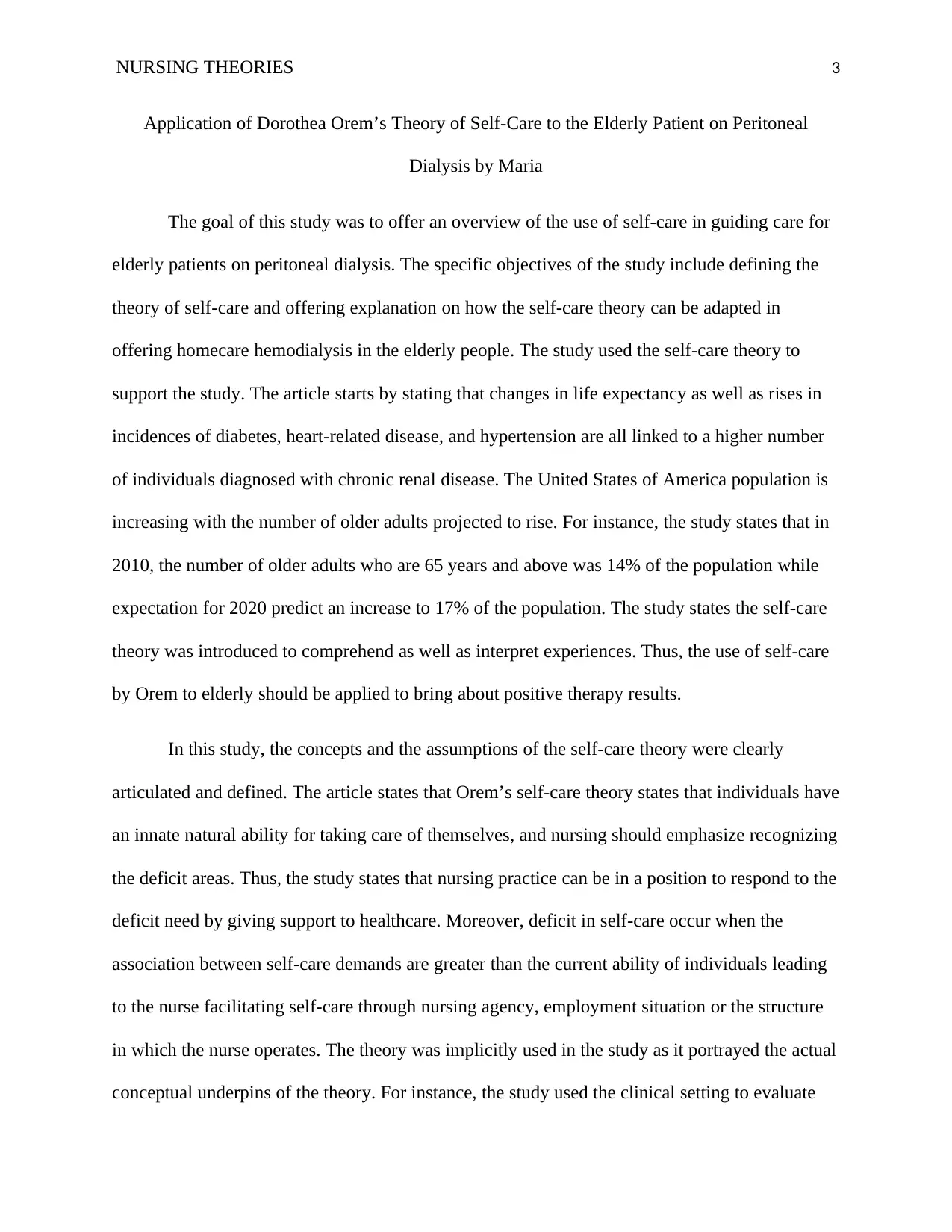
NURSING THEORIES 3
Application of Dorothea Orem’s Theory of Self-Care to the Elderly Patient on Peritoneal
Dialysis by Maria
The goal of this study was to offer an overview of the use of self-care in guiding care for
elderly patients on peritoneal dialysis. The specific objectives of the study include defining the
theory of self-care and offering explanation on how the self-care theory can be adapted in
offering homecare hemodialysis in the elderly people. The study used the self-care theory to
support the study. The article starts by stating that changes in life expectancy as well as rises in
incidences of diabetes, heart-related disease, and hypertension are all linked to a higher number
of individuals diagnosed with chronic renal disease. The United States of America population is
increasing with the number of older adults projected to rise. For instance, the study states that in
2010, the number of older adults who are 65 years and above was 14% of the population while
expectation for 2020 predict an increase to 17% of the population. The study states the self-care
theory was introduced to comprehend as well as interpret experiences. Thus, the use of self-care
by Orem to elderly should be applied to bring about positive therapy results.
In this study, the concepts and the assumptions of the self-care theory were clearly
articulated and defined. The article states that Orem’s self-care theory states that individuals have
an innate natural ability for taking care of themselves, and nursing should emphasize recognizing
the deficit areas. Thus, the study states that nursing practice can be in a position to respond to the
deficit need by giving support to healthcare. Moreover, deficit in self-care occur when the
association between self-care demands are greater than the current ability of individuals leading
to the nurse facilitating self-care through nursing agency, employment situation or the structure
in which the nurse operates. The theory was implicitly used in the study as it portrayed the actual
conceptual underpins of the theory. For instance, the study used the clinical setting to evaluate
Application of Dorothea Orem’s Theory of Self-Care to the Elderly Patient on Peritoneal
Dialysis by Maria
The goal of this study was to offer an overview of the use of self-care in guiding care for
elderly patients on peritoneal dialysis. The specific objectives of the study include defining the
theory of self-care and offering explanation on how the self-care theory can be adapted in
offering homecare hemodialysis in the elderly people. The study used the self-care theory to
support the study. The article starts by stating that changes in life expectancy as well as rises in
incidences of diabetes, heart-related disease, and hypertension are all linked to a higher number
of individuals diagnosed with chronic renal disease. The United States of America population is
increasing with the number of older adults projected to rise. For instance, the study states that in
2010, the number of older adults who are 65 years and above was 14% of the population while
expectation for 2020 predict an increase to 17% of the population. The study states the self-care
theory was introduced to comprehend as well as interpret experiences. Thus, the use of self-care
by Orem to elderly should be applied to bring about positive therapy results.
In this study, the concepts and the assumptions of the self-care theory were clearly
articulated and defined. The article states that Orem’s self-care theory states that individuals have
an innate natural ability for taking care of themselves, and nursing should emphasize recognizing
the deficit areas. Thus, the study states that nursing practice can be in a position to respond to the
deficit need by giving support to healthcare. Moreover, deficit in self-care occur when the
association between self-care demands are greater than the current ability of individuals leading
to the nurse facilitating self-care through nursing agency, employment situation or the structure
in which the nurse operates. The theory was implicitly used in the study as it portrayed the actual
conceptual underpins of the theory. For instance, the study used the clinical setting to evaluate
⊘ This is a preview!⊘
Do you want full access?
Subscribe today to unlock all pages.

Trusted by 1+ million students worldwide
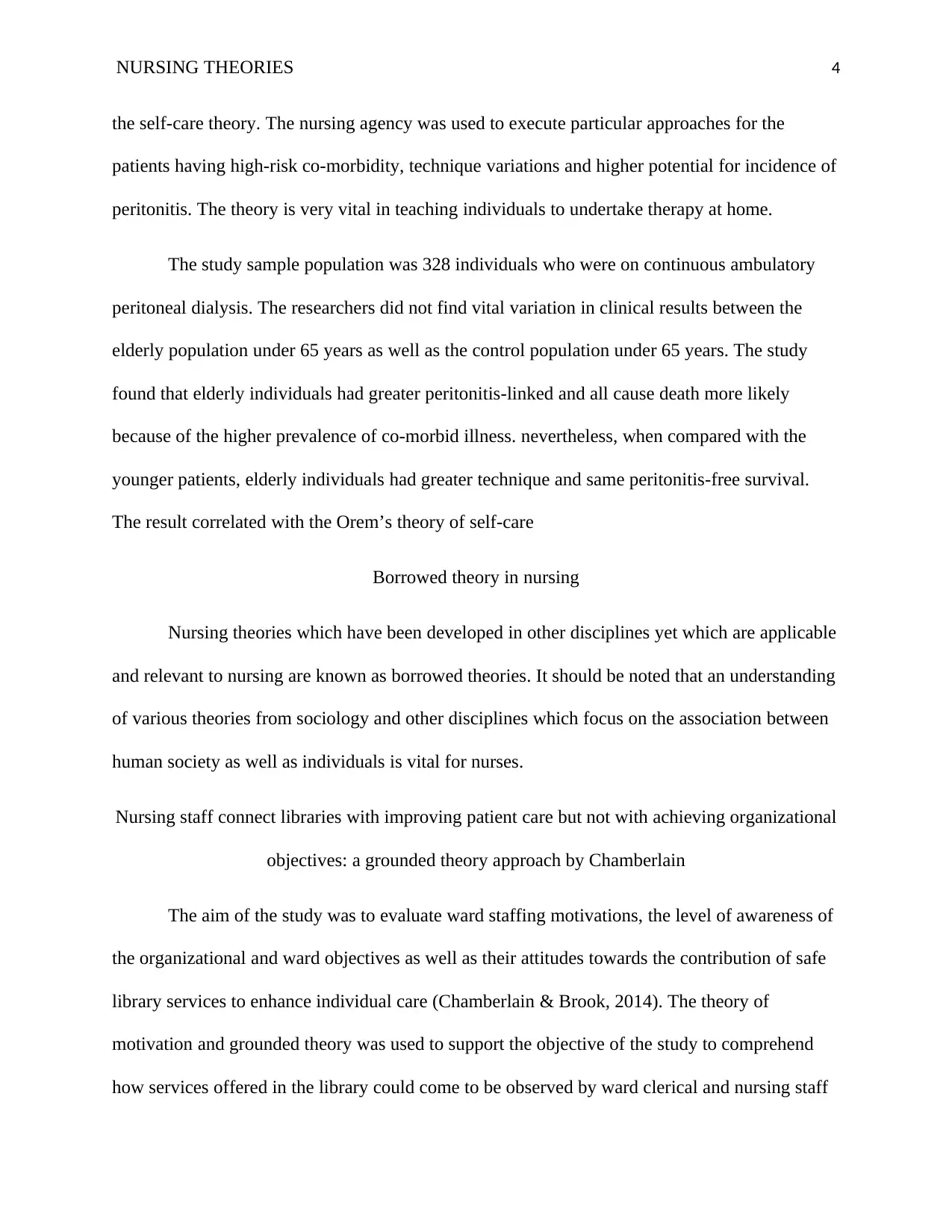
NURSING THEORIES 4
the self-care theory. The nursing agency was used to execute particular approaches for the
patients having high-risk co-morbidity, technique variations and higher potential for incidence of
peritonitis. The theory is very vital in teaching individuals to undertake therapy at home.
The study sample population was 328 individuals who were on continuous ambulatory
peritoneal dialysis. The researchers did not find vital variation in clinical results between the
elderly population under 65 years as well as the control population under 65 years. The study
found that elderly individuals had greater peritonitis-linked and all cause death more likely
because of the higher prevalence of co-morbid illness. nevertheless, when compared with the
younger patients, elderly individuals had greater technique and same peritonitis-free survival.
The result correlated with the Orem’s theory of self-care
Borrowed theory in nursing
Nursing theories which have been developed in other disciplines yet which are applicable
and relevant to nursing are known as borrowed theories. It should be noted that an understanding
of various theories from sociology and other disciplines which focus on the association between
human society as well as individuals is vital for nurses.
Nursing staff connect libraries with improving patient care but not with achieving organizational
objectives: a grounded theory approach by Chamberlain
The aim of the study was to evaluate ward staffing motivations, the level of awareness of
the organizational and ward objectives as well as their attitudes towards the contribution of safe
library services to enhance individual care (Chamberlain & Brook, 2014). The theory of
motivation and grounded theory was used to support the objective of the study to comprehend
how services offered in the library could come to be observed by ward clerical and nursing staff
the self-care theory. The nursing agency was used to execute particular approaches for the
patients having high-risk co-morbidity, technique variations and higher potential for incidence of
peritonitis. The theory is very vital in teaching individuals to undertake therapy at home.
The study sample population was 328 individuals who were on continuous ambulatory
peritoneal dialysis. The researchers did not find vital variation in clinical results between the
elderly population under 65 years as well as the control population under 65 years. The study
found that elderly individuals had greater peritonitis-linked and all cause death more likely
because of the higher prevalence of co-morbid illness. nevertheless, when compared with the
younger patients, elderly individuals had greater technique and same peritonitis-free survival.
The result correlated with the Orem’s theory of self-care
Borrowed theory in nursing
Nursing theories which have been developed in other disciplines yet which are applicable
and relevant to nursing are known as borrowed theories. It should be noted that an understanding
of various theories from sociology and other disciplines which focus on the association between
human society as well as individuals is vital for nurses.
Nursing staff connect libraries with improving patient care but not with achieving organizational
objectives: a grounded theory approach by Chamberlain
The aim of the study was to evaluate ward staffing motivations, the level of awareness of
the organizational and ward objectives as well as their attitudes towards the contribution of safe
library services to enhance individual care (Chamberlain & Brook, 2014). The theory of
motivation and grounded theory was used to support the objective of the study to comprehend
how services offered in the library could come to be observed by ward clerical and nursing staff
Paraphrase This Document
Need a fresh take? Get an instant paraphrase of this document with our AI Paraphraser
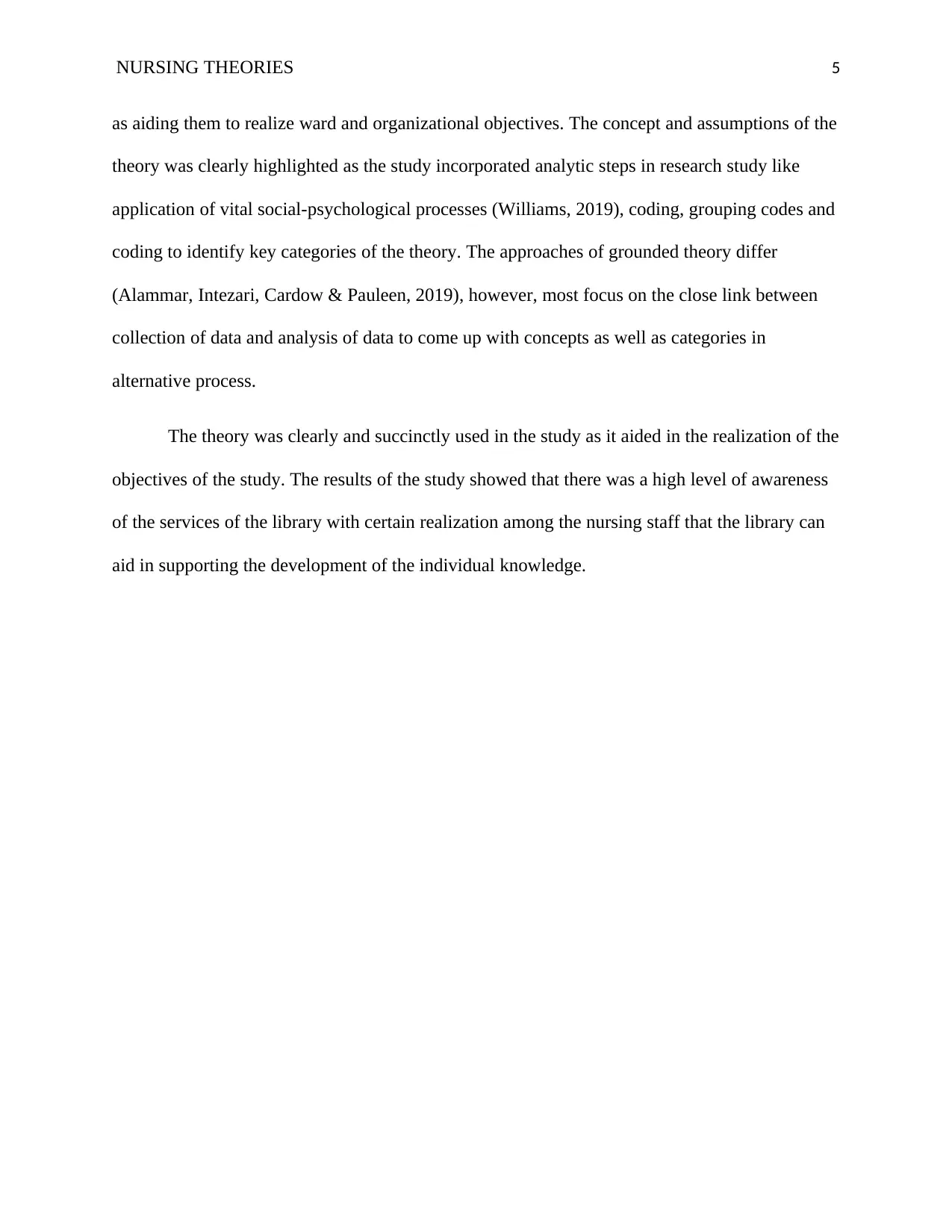
NURSING THEORIES 5
as aiding them to realize ward and organizational objectives. The concept and assumptions of the
theory was clearly highlighted as the study incorporated analytic steps in research study like
application of vital social-psychological processes (Williams, 2019), coding, grouping codes and
coding to identify key categories of the theory. The approaches of grounded theory differ
(Alammar, Intezari, Cardow & Pauleen, 2019), however, most focus on the close link between
collection of data and analysis of data to come up with concepts as well as categories in
alternative process.
The theory was clearly and succinctly used in the study as it aided in the realization of the
objectives of the study. The results of the study showed that there was a high level of awareness
of the services of the library with certain realization among the nursing staff that the library can
aid in supporting the development of the individual knowledge.
as aiding them to realize ward and organizational objectives. The concept and assumptions of the
theory was clearly highlighted as the study incorporated analytic steps in research study like
application of vital social-psychological processes (Williams, 2019), coding, grouping codes and
coding to identify key categories of the theory. The approaches of grounded theory differ
(Alammar, Intezari, Cardow & Pauleen, 2019), however, most focus on the close link between
collection of data and analysis of data to come up with concepts as well as categories in
alternative process.
The theory was clearly and succinctly used in the study as it aided in the realization of the
objectives of the study. The results of the study showed that there was a high level of awareness
of the services of the library with certain realization among the nursing staff that the library can
aid in supporting the development of the individual knowledge.
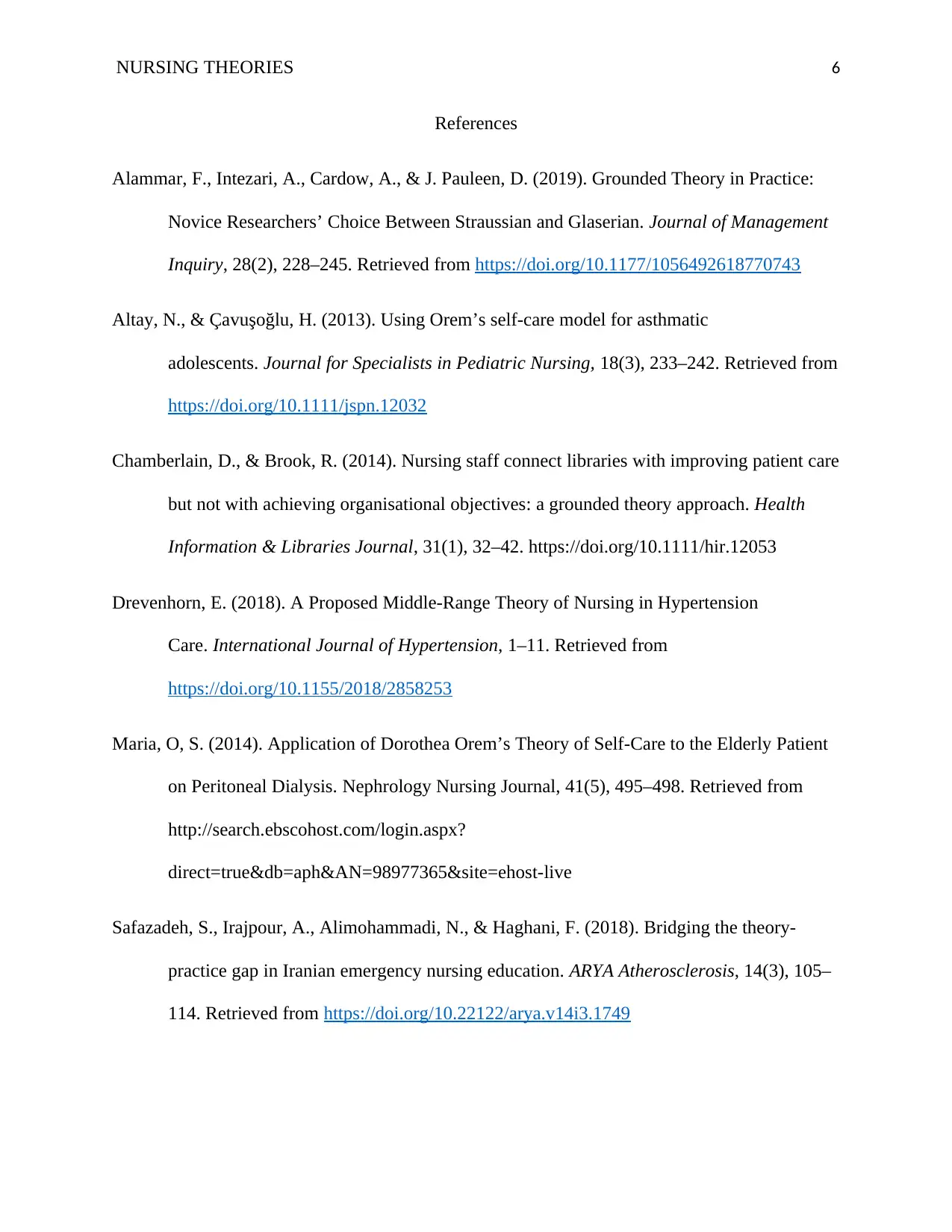
NURSING THEORIES 6
References
Alammar, F., Intezari, A., Cardow, A., & J. Pauleen, D. (2019). Grounded Theory in Practice:
Novice Researchers’ Choice Between Straussian and Glaserian. Journal of Management
Inquiry, 28(2), 228–245. Retrieved from https://doi.org/10.1177/1056492618770743
Altay, N., & Çavuşoğlu, H. (2013). Using Orem’s self-care model for asthmatic
adolescents. Journal for Specialists in Pediatric Nursing, 18(3), 233–242. Retrieved from
https://doi.org/10.1111/jspn.12032
Chamberlain, D., & Brook, R. (2014). Nursing staff connect libraries with improving patient care
but not with achieving organisational objectives: a grounded theory approach. Health
Information & Libraries Journal, 31(1), 32–42. https://doi.org/10.1111/hir.12053
Drevenhorn, E. (2018). A Proposed Middle-Range Theory of Nursing in Hypertension
Care. International Journal of Hypertension, 1–11. Retrieved from
https://doi.org/10.1155/2018/2858253
Maria, O, S. (2014). Application of Dorothea Orem’s Theory of Self-Care to the Elderly Patient
on Peritoneal Dialysis. Nephrology Nursing Journal, 41(5), 495–498. Retrieved from
http://search.ebscohost.com/login.aspx?
direct=true&db=aph&AN=98977365&site=ehost-live
Safazadeh, S., Irajpour, A., Alimohammadi, N., & Haghani, F. (2018). Bridging the theory-
practice gap in Iranian emergency nursing education. ARYA Atherosclerosis, 14(3), 105–
114. Retrieved from https://doi.org/10.22122/arya.v14i3.1749
References
Alammar, F., Intezari, A., Cardow, A., & J. Pauleen, D. (2019). Grounded Theory in Practice:
Novice Researchers’ Choice Between Straussian and Glaserian. Journal of Management
Inquiry, 28(2), 228–245. Retrieved from https://doi.org/10.1177/1056492618770743
Altay, N., & Çavuşoğlu, H. (2013). Using Orem’s self-care model for asthmatic
adolescents. Journal for Specialists in Pediatric Nursing, 18(3), 233–242. Retrieved from
https://doi.org/10.1111/jspn.12032
Chamberlain, D., & Brook, R. (2014). Nursing staff connect libraries with improving patient care
but not with achieving organisational objectives: a grounded theory approach. Health
Information & Libraries Journal, 31(1), 32–42. https://doi.org/10.1111/hir.12053
Drevenhorn, E. (2018). A Proposed Middle-Range Theory of Nursing in Hypertension
Care. International Journal of Hypertension, 1–11. Retrieved from
https://doi.org/10.1155/2018/2858253
Maria, O, S. (2014). Application of Dorothea Orem’s Theory of Self-Care to the Elderly Patient
on Peritoneal Dialysis. Nephrology Nursing Journal, 41(5), 495–498. Retrieved from
http://search.ebscohost.com/login.aspx?
direct=true&db=aph&AN=98977365&site=ehost-live
Safazadeh, S., Irajpour, A., Alimohammadi, N., & Haghani, F. (2018). Bridging the theory-
practice gap in Iranian emergency nursing education. ARYA Atherosclerosis, 14(3), 105–
114. Retrieved from https://doi.org/10.22122/arya.v14i3.1749
⊘ This is a preview!⊘
Do you want full access?
Subscribe today to unlock all pages.

Trusted by 1+ million students worldwide
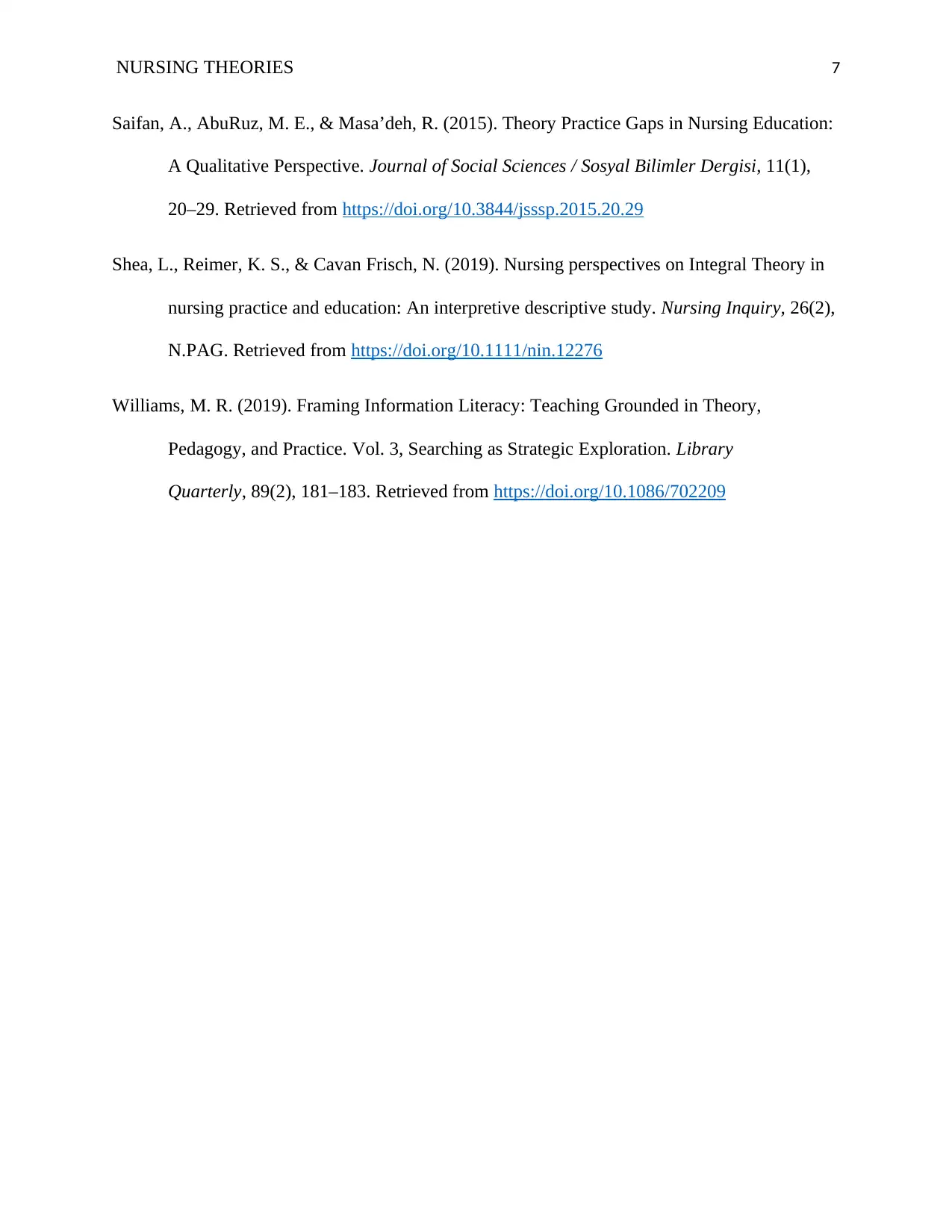
NURSING THEORIES 7
Saifan, A., AbuRuz, M. E., & Masa’deh, R. (2015). Theory Practice Gaps in Nursing Education:
A Qualitative Perspective. Journal of Social Sciences / Sosyal Bilimler Dergisi, 11(1),
20–29. Retrieved from https://doi.org/10.3844/jsssp.2015.20.29
Shea, L., Reimer, K. S., & Cavan Frisch, N. (2019). Nursing perspectives on Integral Theory in
nursing practice and education: An interpretive descriptive study. Nursing Inquiry, 26(2),
N.PAG. Retrieved from https://doi.org/10.1111/nin.12276
Williams, M. R. (2019). Framing Information Literacy: Teaching Grounded in Theory,
Pedagogy, and Practice. Vol. 3, Searching as Strategic Exploration. Library
Quarterly, 89(2), 181–183. Retrieved from https://doi.org/10.1086/702209
Saifan, A., AbuRuz, M. E., & Masa’deh, R. (2015). Theory Practice Gaps in Nursing Education:
A Qualitative Perspective. Journal of Social Sciences / Sosyal Bilimler Dergisi, 11(1),
20–29. Retrieved from https://doi.org/10.3844/jsssp.2015.20.29
Shea, L., Reimer, K. S., & Cavan Frisch, N. (2019). Nursing perspectives on Integral Theory in
nursing practice and education: An interpretive descriptive study. Nursing Inquiry, 26(2),
N.PAG. Retrieved from https://doi.org/10.1111/nin.12276
Williams, M. R. (2019). Framing Information Literacy: Teaching Grounded in Theory,
Pedagogy, and Practice. Vol. 3, Searching as Strategic Exploration. Library
Quarterly, 89(2), 181–183. Retrieved from https://doi.org/10.1086/702209
1 out of 7
Related Documents
Your All-in-One AI-Powered Toolkit for Academic Success.
+13062052269
info@desklib.com
Available 24*7 on WhatsApp / Email
![[object Object]](/_next/static/media/star-bottom.7253800d.svg)
Unlock your academic potential
Copyright © 2020–2025 A2Z Services. All Rights Reserved. Developed and managed by ZUCOL.





